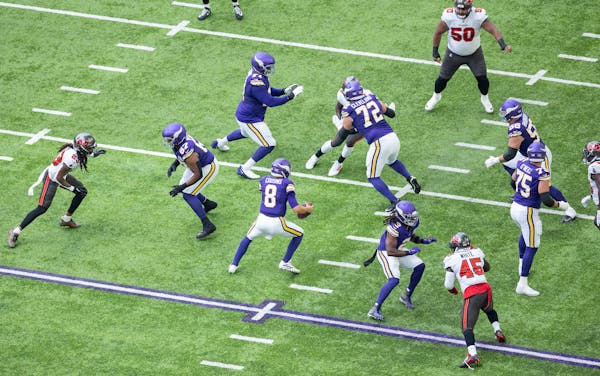The second phase of U.S. Bank Stadium's enhanced security perimeter is expected to cost $62 million, a sum that the Minnesota Sports Facilities Authority (MSFA) will ask Gov. Tim Walz and the 2024 Legislature to provide, according to a report Thursday.
Kansas City, Mo.-based Populous architect Tyler Robertson gave an update with the cost estimate and detailed renderings of the fortified perimeter at the regularly scheduled MSFA monthly meeting. The Minnesota Vikings are the primary tenant in the state-owned building.
Officials say the main goal of the enhanced perimeter is to meet Department of Homeland Security anti-terrorism standards and protect those attending events inside the stadium without restricting access and movement. The MSFA also approved replacing the synthetic turf in the stadium for the second time since the building opened for the 2016 NFL season.
Chair Michael Vekich said the MSFA doesn't have the money for phase two of the perimeter, initially estimated at $48 million, so it will ask the Legislature and Walz for the $62 million.
"This is a very exciting project. It really completes the vision for this stadium," Vekich said.
The first phase of the enhanced fencing, which included much of the building except the main western entrance, will be done in May. The 2023 Legislature and Walz authorized $15.7 million for the first phase.
At the meeting, Vekich said the perimeter will preserve access to the building while protecting the seven-year-old stadium, a state asset that cost $1.1 billion in public and private money.
In the first phase, 6-foot temporary chain-link fencing was replaced with permanent 8-foot fencing that cannot be climbed. The second phase will be more obvious, involving the western entrance of the building facing downtown, the light-rail station, the Medtronic plaza and the skyway connection.
Robertson said phase two completes the "vision for an inviting outdoor public space that is now the front door for U.S. Bank Stadium."
In addition to modernizing security access, the renderings showed permanent entry gates that are open on non-event days for public access and improved visibility to "elevate the appearance of U.S. Bank Stadium."
The entries will be designed to provide swift, frictionless access during high-attendance events to improve the fan experience and encourage repeat visits, Robertson said.
The big question with the second phase of the perimeter is the cost. Failure to upgrade the perimeter could result in the stadium's loss of certification under the federal Safety Act standards and that could mean losing events, Vekich said.
Asked what would happen if the Legislature doesn't fund the project next year, Vekich declined to speculate. The plan is to begin construction in late 2024.
Once complete, the perimeter will lift the stadium's security level to K12 under Department of State anti-terrorism threat levels. The standard means the perimeter can stop a 15,000-pound vehicle traveling at 50 miles per hour, protecting the more than 60,000 fans inside during Vikings games.
The initial phase of the fencing included the north, eastern and southern sides of the building. In addition to the anti-climb fencing, it includes new gates, crash-prevention bollards and in-ground wedge barriers.
The MSFA, which oversees the state-owned building on behalf of the public, also chose Austin, Texas-based Act Global to install new turf in early 2024 for $1.3 million. Unlike the slit film style of the current turf, the new grass will be monofilament, the preferred choice of the National Football League Players Association, the players union.
Vikings Executive Vice President Steve Poppen said in an interview that the new turf provides a "slightly better safety experience." He and Vekich said the replacement plan began last summer — before star receiver Justin Jefferson's serious hamstring injury on Oct. 8 at U.S. Bank Stadium in the game against the Kansas City Chiefs that sidelined him for part of the season.
Vekich said the turf is at the end of its life.
Money to replace the turf comes from an existing MSFA capital account funded by both the state and the Vikings for routine maintenance.
This is the second time the turf has been replaced in the building that's played host to eight NFL seasons as well as soccer, high school football, collegiate baseball, Garth Brooks, Taylor Swift and Metallica concerts.
Poppen said the Vikings plan to install identical new turf in their Eagan indoor practice facility at their headquarters. The team will cover that cost.
In 2012, the Legislature and Gov. Mark Dayton agreed to build the stadium with the Minnesota Vikings. The state covered $348 million, Minneapolis was to pay $150 million with the Vikings' owners paying the rest. The bonds for the building were paid off earlier this year — more than two decades in advance.
Vekich said the building must be maintained as a first-class venue and that's where state money is needed.
While it wasn't under discussion Thursday, an MSFA study determined the building will need $280 million in maintenance in the coming decade, a number that included the initial estimate of $48 million for the next phase of the perimeter.
The turf replacement will take six weeks, forcing University of Minnesota baseball to find an alternate venue for the 2024 season.
Arizona judge rejects GOP wording for voters' abortion ballot initiative pamphlet
FBI says Trump was indeed struck by bullet during assassination attempt





